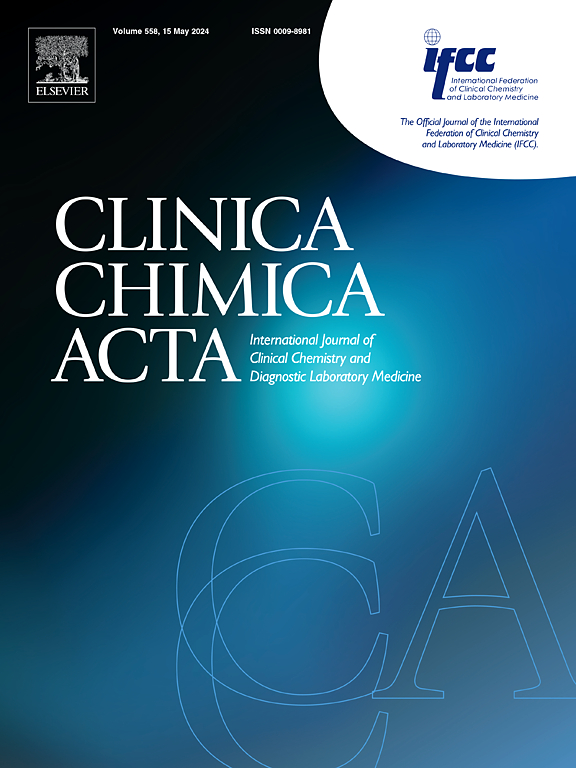Circulating levels of PADs and citrullinated histone H3 in SARS-CoV-2 infection: Influence of genetic polymorphisms
IF 3.2
3区 医学
Q2 MEDICAL LABORATORY TECHNOLOGY
引用次数: 0
Abstract
Background
Peptidyl arginine deiminases (PADs) and citrullinated H3 histone (H3Cit) play a crucial role in the inflammatory response. These components determine various clinical situations in COVID-2019 associated pneumonia. Single nucleotide polymorphisms (SNPs) in the genes PADI2 and PADI4 may influence the outcome of poorer patient outcomes. We analyze the association of circulating levels NETs biomarkers (PAD2, PAD4, and H3Cit) and the SNPs on PADI2 (rs1005753 and rs2235926) and PADI4 (rs11203366, rs11203367, and rs874881) in hospitalized patients with severe acute respiratory distress syndrome (ARDs) by SARS-CoV-2 pneumonia.
Methods
A cross-sectional study in 160 hospitalized patients with ARDs by SARS-CoV-2 pneumonia. The plasma levels of PAD2, PAD4, and H3Cit were determined by ELISA method. The SNPs were determined by qPCR using TaqMan probes. Logistic regression models and receiver operating characteristics (ROC) curve were used to assess the association and predictive value of PAD2, PAD4, and H3Cit plasma levels in outcome by ARDs by SARS-CoV-2 pneumonia.
Results
PAD2, PAD4, and H3Cit concentrations were predictors of invasive mechanical ventilation (IMV) requirement and non-survival. PAD2 were associated with non-survival, while PAD4 and H3Cit were associated with requirement IMV. In addition, PAD2 and PAD4 concentrations were related with inflammation markers such as NLR, MLR, dNLR, SII, SIRI, AISI, and NHL. In the carriers of TT genotype of rs1005753 of PADI2 were associated with increased of H3Cit, while, the carriers of GTG/GTG haplotype of PADI4 was related to the presence of increased of PAD4 circulating levels.
Conclusion
SNPs in PADI2 and PADI4 have a significant influence on concentrations of PAD2, PAD4, and H3Cit, which are predictor markers of requirement IMV and non-survival in severe ARDS by SARS-CoV-2 pneumonia.
求助全文
约1分钟内获得全文
求助全文
来源期刊

Clinica Chimica Acta
医学-医学实验技术
CiteScore
10.10
自引率
2.00%
发文量
1268
审稿时长
23 days
期刊介绍:
The Official Journal of the International Federation of Clinical Chemistry and Laboratory Medicine (IFCC)
Clinica Chimica Acta is a high-quality journal which publishes original Research Communications in the field of clinical chemistry and laboratory medicine, defined as the diagnostic application of chemistry, biochemistry, immunochemistry, biochemical aspects of hematology, toxicology, and molecular biology to the study of human disease in body fluids and cells.
The objective of the journal is to publish novel information leading to a better understanding of biological mechanisms of human diseases, their prevention, diagnosis, and patient management. Reports of an applied clinical character are also welcome. Papers concerned with normal metabolic processes or with constituents of normal cells or body fluids, such as reports of experimental or clinical studies in animals, are only considered when they are clearly and directly relevant to human disease. Evaluation of commercial products have a low priority for publication, unless they are novel or represent a technological breakthrough. Studies dealing with effects of drugs and natural products and studies dealing with the redox status in various diseases are not within the journal''s scope. Development and evaluation of novel analytical methodologies where applicable to diagnostic clinical chemistry and laboratory medicine, including point-of-care testing, and topics on laboratory management and informatics will also be considered. Studies focused on emerging diagnostic technologies and (big) data analysis procedures including digitalization, mobile Health, and artificial Intelligence applied to Laboratory Medicine are also of interest.
 求助内容:
求助内容: 应助结果提醒方式:
应助结果提醒方式:


